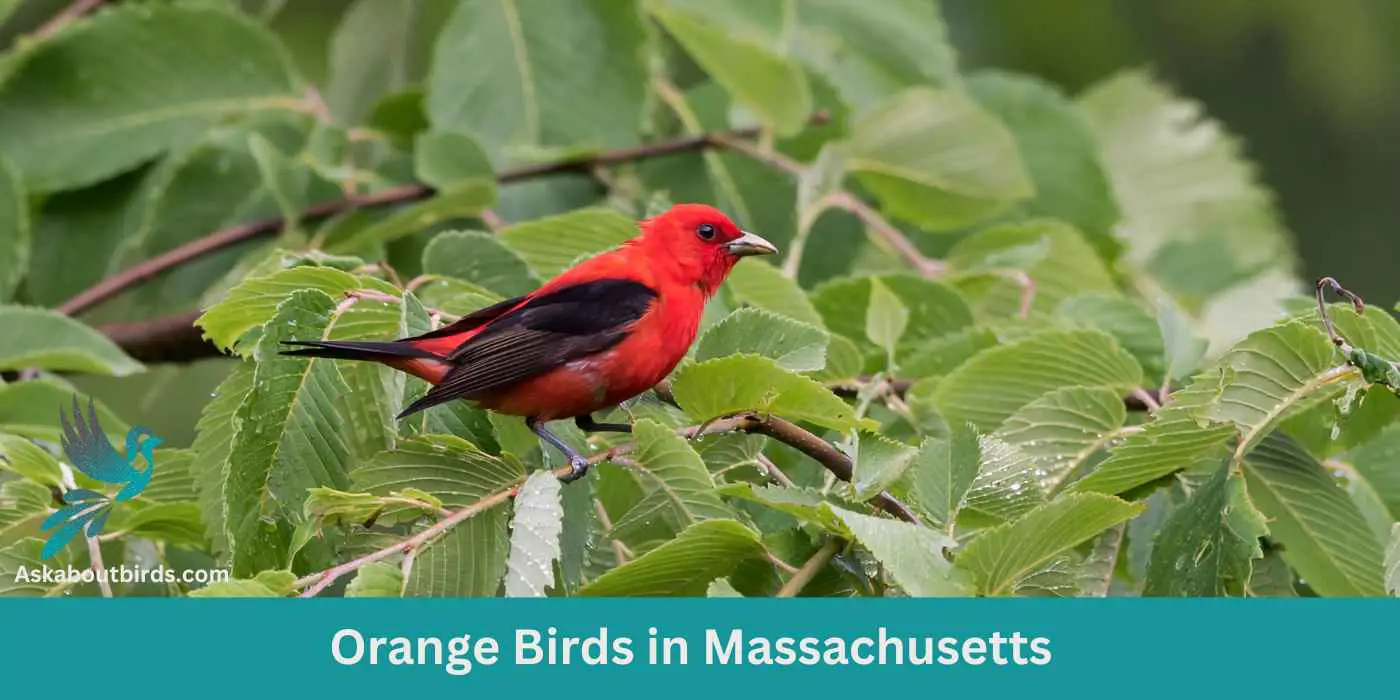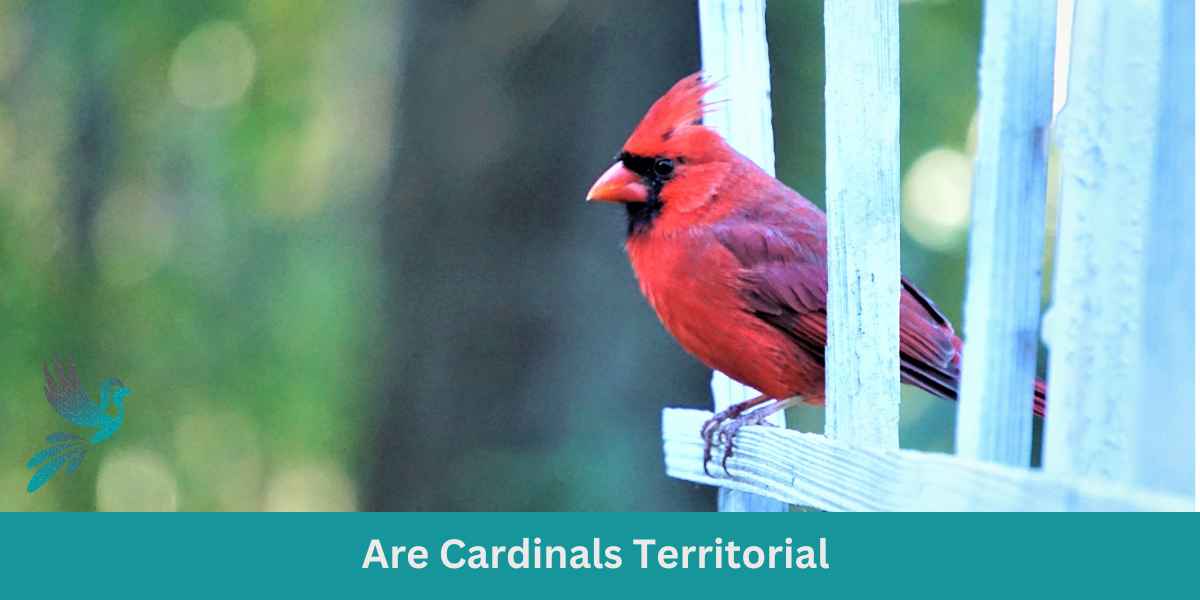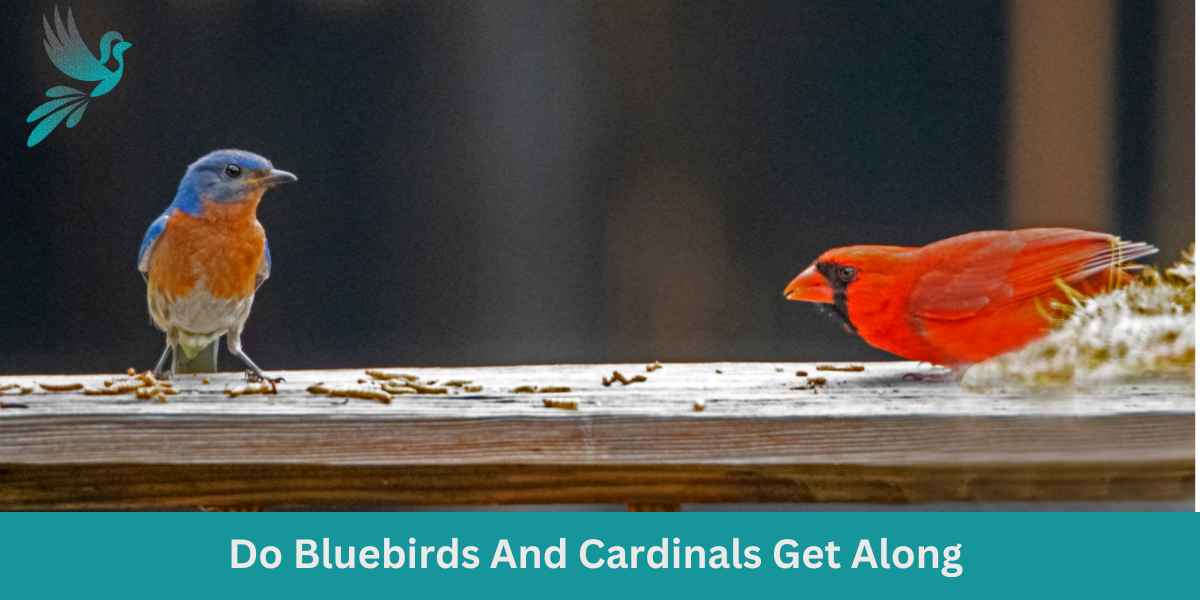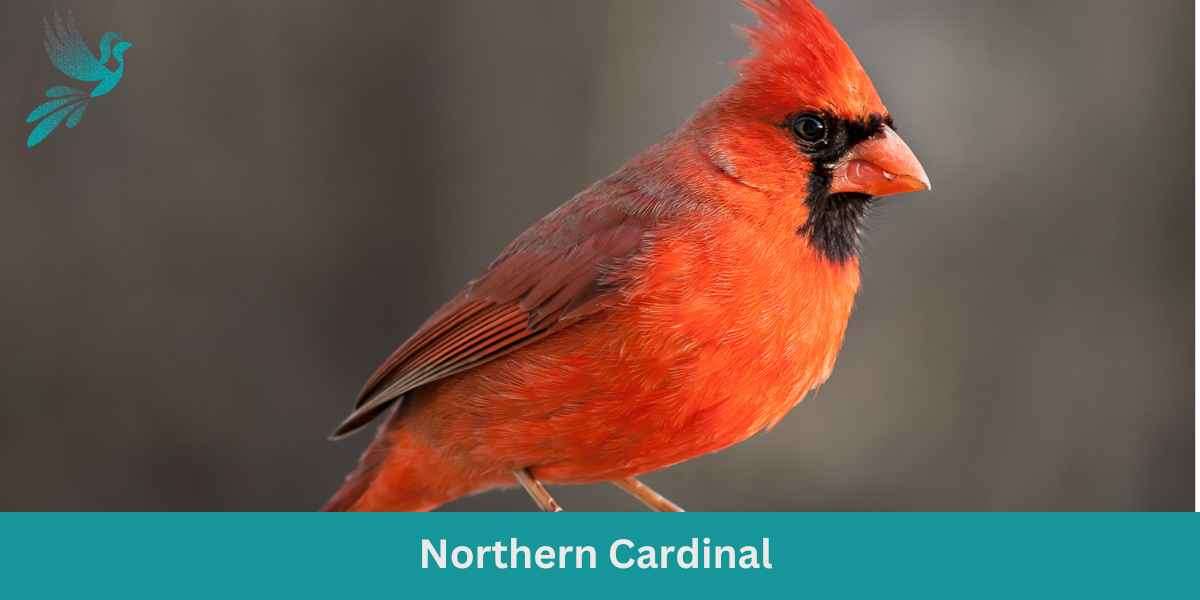Massachusetts, often celebrated for its historical landmarks and scenic coastlines, also serves as a haven for bird enthusiasts. The state’s diverse ecosystems, from coastal marshes to thick woodlands, are a magnet for a myriad of avian species. Among the feathery residents and visitors, the orange-hued birds hold a special allure.
Journey with us as we explore 9 mesmerizing orange birds that grace the skies and landscapes of Massachusetts, each telling a unique story of nature’s artistry.
Orange Birds Found In Massachusetts
Massachusetts’ diverse landscapes, from coastal marshes to dense forests, create a rich tapestry that attracts a wide array of avian species.
Baltimore Oriole
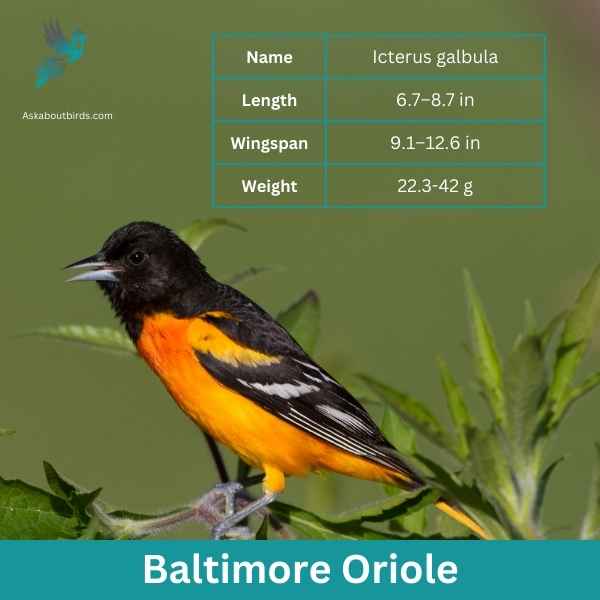
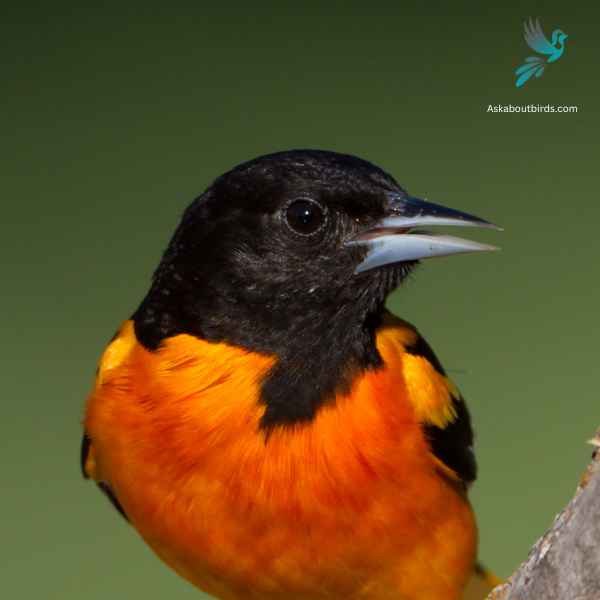
| Feature | Measurement |
|---|---|
| Scientific Name | Icterus galbula |
| Length | 6.7–8.7 in |
| Wingspan | 9.1–12.6 in |
| Weight | 22.3-42 g |
The Baltimore Oriole is a stunning bird, best known for its vibrant coloration and its rich, whistling song.
Appearance: The male Baltimore Oriole is notable for his bright orange and black plumage and black and white wing bars, a stark contrast to the more muted yellow-brown coloration of the female. Both sexes, however, have long pointed bills and white bars on their wings.
Diet: Baltimore Orioles have a diverse diet that includes insects, fruits, and nectar. Their preference for sweet juices and fruit pulp often brings them to backyard feeders offering oranges and jelly.
Reproduction: The female Baltimore Oriole is responsible for building the distinctive hanging nest, often woven together from fine materials like hair and grass. These nests are usually high in trees to avoid predators. The female lays 3-7 eggs, which are incubated for about two weeks.
Orchard Oriole
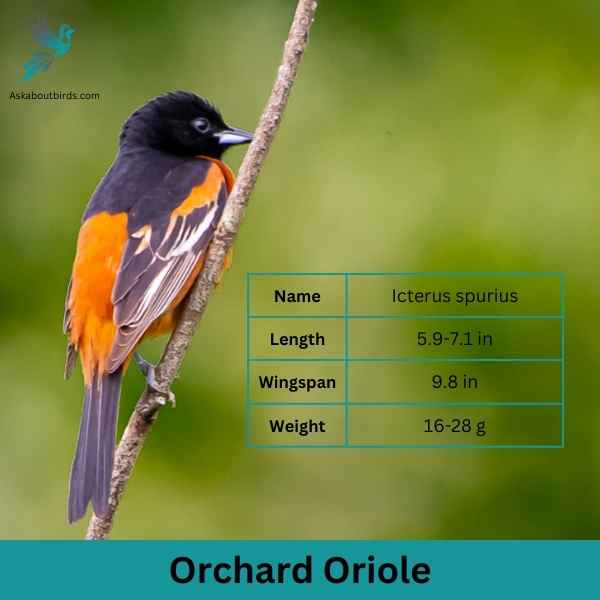
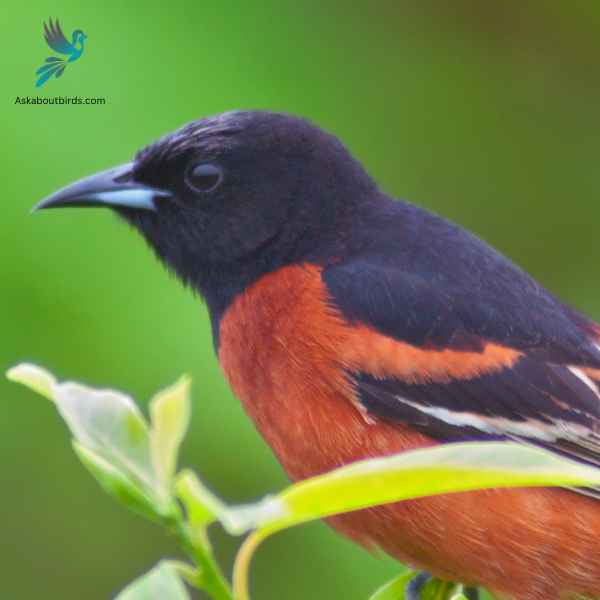
| Feature | Measurement |
|---|---|
| Scientific Name | Icterus spurius |
| Length | 5.9-7.1 in |
| Wingspan | 9.8 in |
| Weight | 16-28 g |
The Orchard Oriole is a small songbird noted for its distinctive coloration and melodic song.
Appearance: Male Orchard Orioles are a striking sight with their dark chestnut body and black head and black and white wings, while females and immature males are olive-green and feature a yellowish underpart. The species is often recognized by its slender body and pointed bill.
Diet: The diet of the Orchard Oriole consists primarily of insects, fruits, and nectar. They are adept at catching insects mid-air and are also known to sip nectar from flowers, aiding in pollination. When fruits are in season, they make up a substantial portion of the bird’s diet.
Reproduction: Orchard Orioles often nest in open woodlands and orchards, hence their name. The female is responsible for building the nest, typically choosing a location in a tree or shrub. The female lays a clutch of 4 to 6 eggs, which she incubates for about two weeks.
Scarlet Tanager
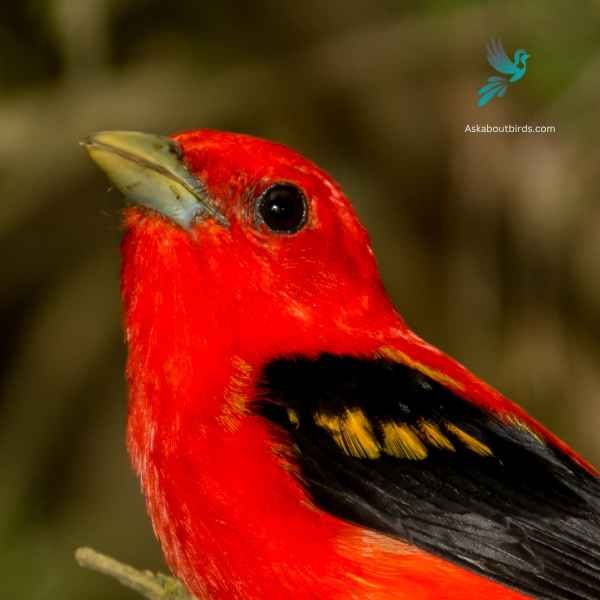
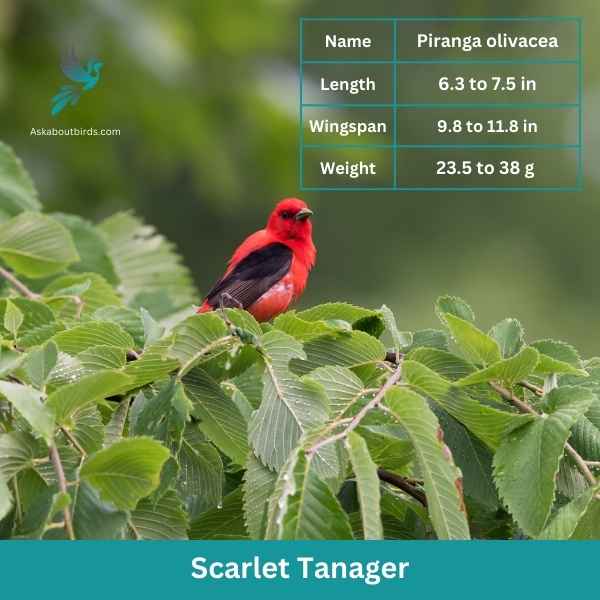
| Feature | Measurement |
|---|---|
| Scientific Name | Piranga olivacea |
| Length | 6.3 to 7.5 in |
| Wingspan | 9.8 to 11.8 in |
| Weight | 23.5 to 38 g |
The Scarlet Tanager is a strikingly colorful bird known for its brilliant plumage and distinctive song.
Appearance: Male Scarlet Tanagers are notable for their vibrant scarlet bodies contrasted with black wings and tail, making them one of the most intensely colored birds. Females and juveniles, on the other hand, have a subdued olive-yellow body color with darker wings and tail.
Diet: The diet of the Scarlet Tanager is largely made up of insects, including beetles, cicadas, aphids, and others. They are adept flycatchers, seizing insects in mid-air or picking them off foliage. They also consume fruits and berries, especially during migration and in their winter habitats.
Reproduction: The female Scarlet Tanager builds a cup-shaped nest using twigs, rootlets, and grass, typically well-hidden in the dense foliage of trees. She lays 3 to 5 eggs and incubates them for about two weeks.
American Redstart
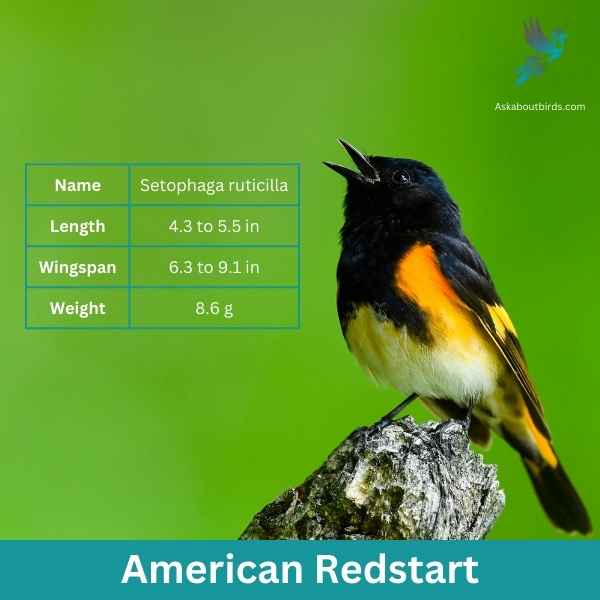
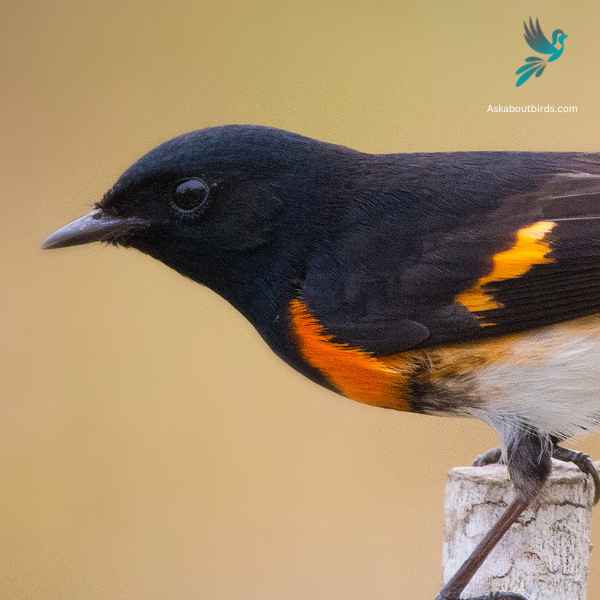
| Feature | Measurement |
|---|---|
| Scientific Name | Setophaga ruticilla |
| Length | 4.3 to 5.5 in |
| Wingspan | 6.3 to 9.1 in |
| Weight | 8.6 g |
The American Redstart is a lively warbler known for its vivid colors and active hunting style, often seen flitting about, fanning its tail to startle and catch insects.
Appearance: Adult male American Redstarts boast striking black plumage with bright orange patches on the sides, wings, and tail. Females and immature males have grayish-olive upperparts with yellow patches in the same areas where the males display orange.
Diet: American Redstarts are primarily insectivores. They actively forage for flying insects, as well as caterpillars and spiders, often using their colorful tails to startle prey and make them easier to catch.
Reproduction: The female American Redstart builds a cup-shaped nest in the fork of a tree branch. Typically, she lays a clutch of 3 to 5 eggs. The female takes on the primary responsibility of incubating the eggs, while both parents participate in feeding the fledglings after they hatch.
Barn Swallow
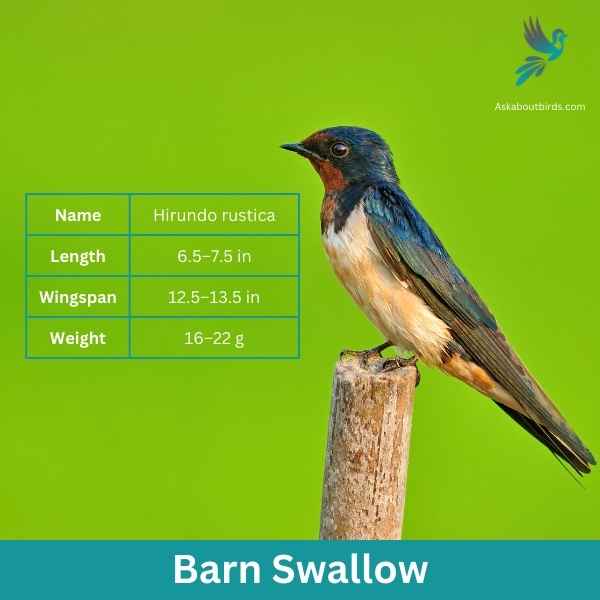
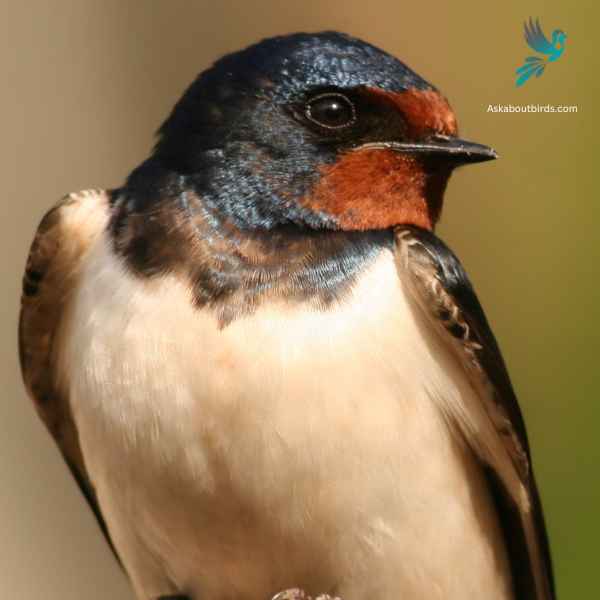
| Feature | Measurement |
|---|---|
| Scientific Name | Hirundo rustica |
| Length | 6.5–7.5 in |
| Wingspan | 12.5–13.5 in |
| Weight | 16–22 g |
The Barn Swallow is a sleek, agile bird renowned for its graceful flight patterns and iconic forked tail, often seen darting over fields and water bodies in search of flying insects.
Appearance: Barn Swallows have deep blue, almost iridescent, upperparts and a rufous to tawny underbelly. Their distinctively forked tail and long wings give them a streamlined look. Both males and females have a similar appearance, though males often exhibit slightly brighter colors and a deeper fork in the tail.
Diet: Barn Swallows feed primarily on flying insects, which they catch in mid-air during their agile and acrobatic flights. Their diet includes flies, beetles, moths, and other small flying insects.
Reproduction: Barn Swallows are known for building their mud nests on man-made structures, particularly barns, bridges, and eaves. The nest is cup-shaped and made from mud pellets, often lined with feathers. The female lays a clutch of 4 to 6 eggs.
Eastern Towhee
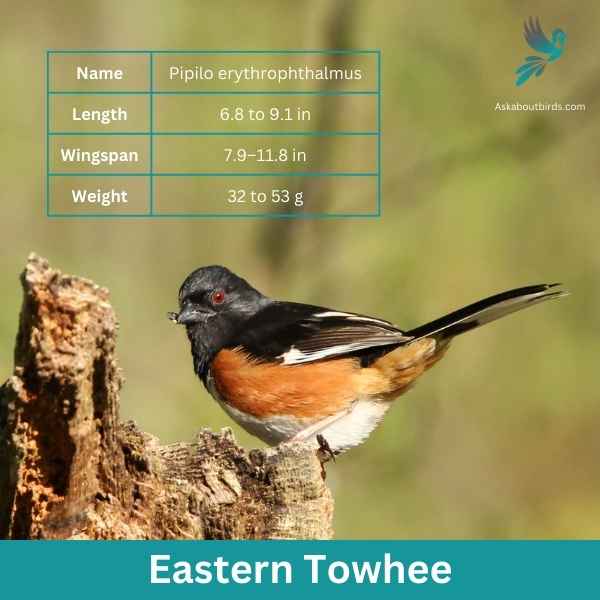
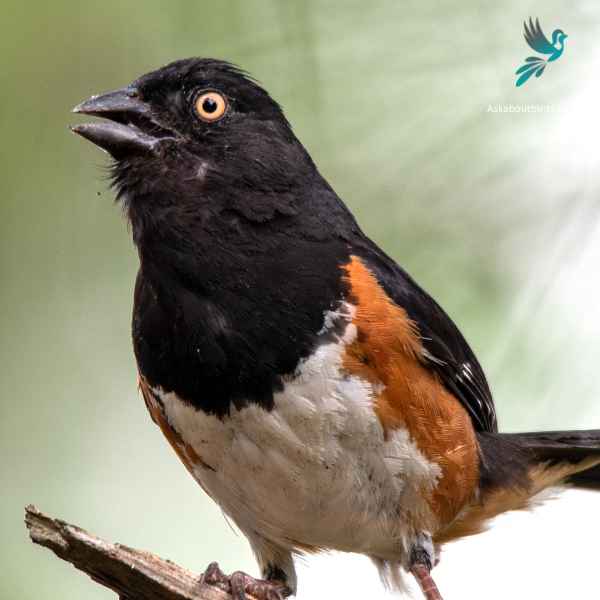
| Feature | Measurement |
|---|---|
| Scientific Name | Pipilo erythrophthalmus |
| Length | 6.8 to 9.1 in |
| Wingspan | 7.9–11.8 in |
| Weight | 32 to 53 g |
The Eastern Towhee is a distinctive songbird known for its unique calls and eye-catching coloration.
Appearance: Male Eastern Towhees are characterized by a striking combination of a black head, back and tail, contrasting with a white belly and rufous flanks. Females sport similar patterns but instead of black, they have a rich brown color. Both genders have red eyes, lending a special charm to their overall appearance.
Diet: Eastern Towhees primarily feed on a variety of insects, seeds, and berries. Their diet is quite diverse, taking advantage of seasonal offerings, which includes beetles, caterpillars, spiders, acorns, grass seeds, and various fruits and berries.
Reproduction: Eastern Towhees build their nests on or near the ground, often in a shrub or a small tree. The female lays around 3-5 eggs and takes the primary role in incubating them over about 12-13 days.
Northern Flicker
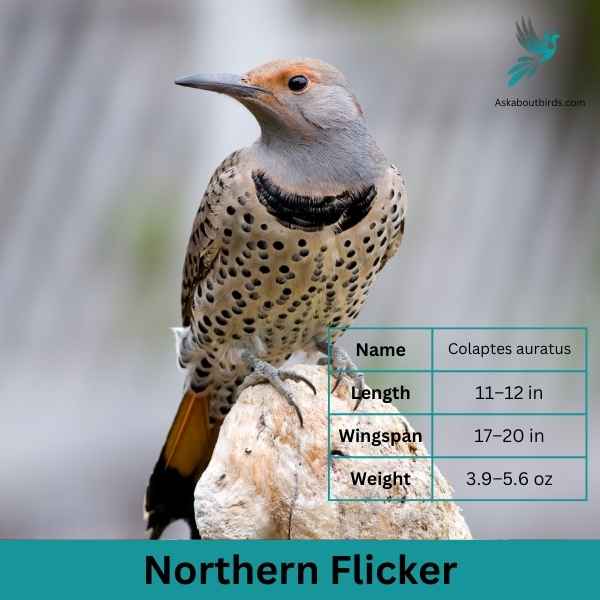
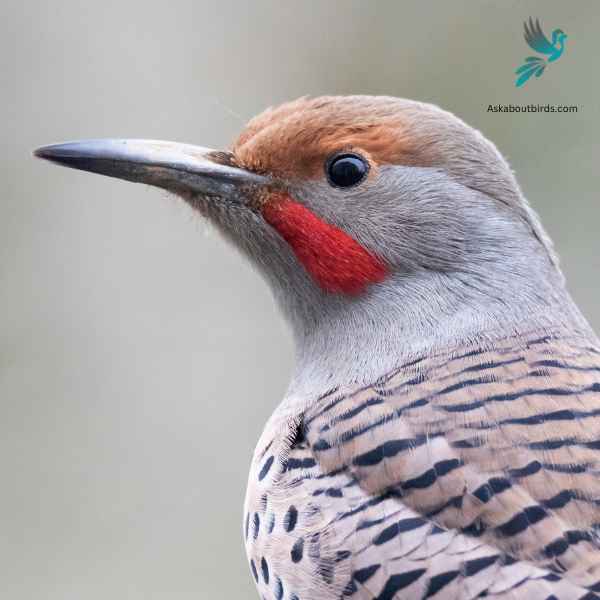
| Feature | Measurement |
|---|---|
| Scientific Name | Colaptes auratus |
| Length | 11–12 in |
| Wingspan | 17–20 in |
| Weight | 3.9–5.6 oz |
The Northern Flicker is a medium-sized woodpecker, recognized by its unique patterns and coloring, often found drumming on trees or foraging on the ground across North America.
Appearance: The Northern Flicker stands out with its grayish brown body, black-scalloped plumage, and a black bib. Males sport a distinctive black or red mustache stripe. Depending on the subspecies, the underwing and undertail feathers can be bright yellow or red, flashing vividly during flight.
Diet: While most woodpeckers are tree-bark foragers, the Northern Flicker prefers hunting on the ground. Its primary diet consists of ants and beetles, supplemented occasionally by fruits, berries, seeds, and other small insects.
Reproduction: Northern Flickers are cavity nesters, preferring to excavate their nesting hole in dead or diseased tree trunks. The interior of the nest is lined with wood chips.
American Robins
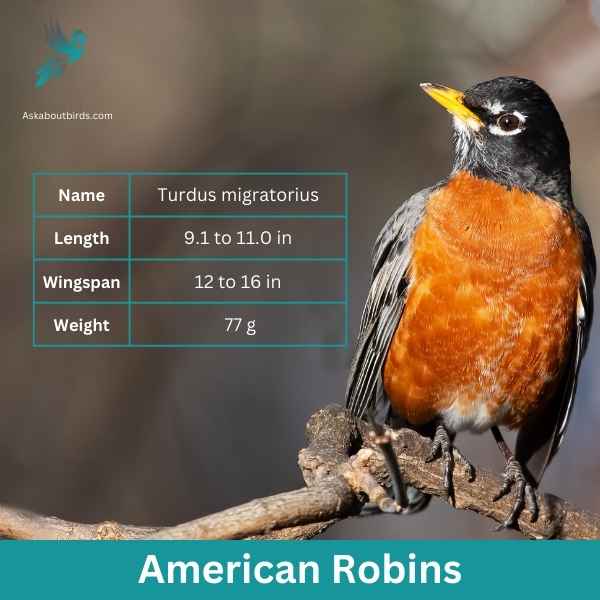
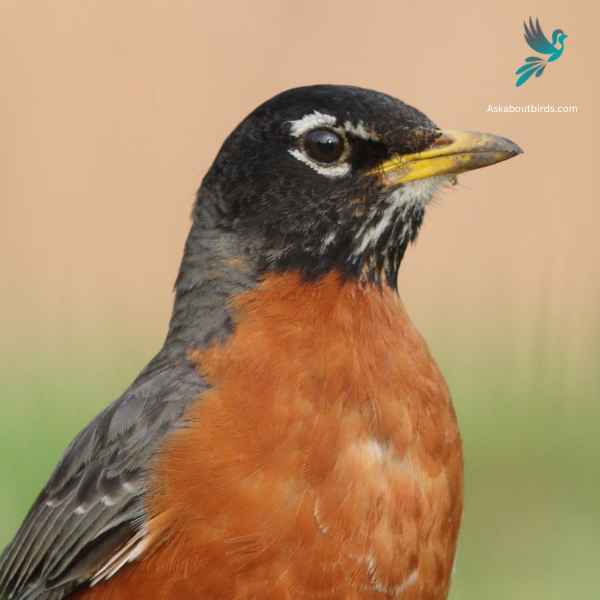
| Feature | Measurement |
|---|---|
| Scientific Name | Leptotila plumbeicep |
| Length | 10.6-11.8 in |
| Wingspan | — |
| Weight | 160-200 g |
The American Robin is a widely recognized bird species known for its melodious song and early bird tendencies.
Appearance: American Robins are medium-sized birds with a distinctive appearance. Both males and females sport a gray to brown back and a warm red to orange breast and belly and gray wings. They also have a characteristic white eye-ring and a black head, but males are usually darker than females.
Diet: American Robins have a diverse diet that changes depending on the season. In summer, they feed heavily on earthworms, beetles, and other invertebrates, which they catch on the ground. During winter, they mostly eat fruits and berries.
Reproduction: American Robins usually build their nests in trees or shrubs, but they are also known to nest on human-made structures. The female lays a clutch of about 3 to 5 eggs, which she incubates for about 12 to 14 days.
Where to Spot Massachusetts’ Orange Birds
Massachusetts, with its mosaic of habitats, offers some of the most captivating birding spots in the Northeast. Here are the top locales renowned for their avian diversity, especially for those seeking the vibrancy of orange birds:
- Monomoy National Wildlife Refuge, Chatham: A vital stopover for migratory birds, this coastal refuge promises glimpses of various songbirds and shorebirds, especially during migration seasons.
- Plum Island/Parker River National Wildlife Refuge: Nestled along the Atlantic Flyway, this sanctuary is a magnet for a diverse range of bird species, making it a favorite among avid bird watchers.
- Quabbin Reservoir, Belchertown: The vast forests surrounding this reservoir provide an ideal habitat for many forest-dwelling birds, offering bird enthusiasts a serene backdrop for their observations.
- Mount Auburn Cemetery, Cambridge: An unexpected urban oasis, this beautifully landscaped space draws numerous songbirds, making it a hotspot for birders, especially in the spring.
- Cape Cod National Seashore: Stretching over 40 miles, this seashore provides varied habitats, from dunes to woodlands, hosting a rich diversity of birdlife throughout the year.
| State’s Orange Birds | Best Spots for Orange Birds |
|---|---|
| Connecticut’s Orange birds | Hammonasset Beach State Park, White Memorial Conservation Center, Island State Park |
| Rhode Island’s Orange birds | Sachuest Point National Wildlife Refuge, Trustom Pond National Wildlife Refuge, Block Island National Wildlife Refuge |
| New Hampshire’s Orange birds | Great Bay National Wildlife Refuge, Pondicherry National Wildlife Refuge, Odiorne Point State Park |
| New York’s Orange birds (though not directly neighboring, it’s close) | Central Park, NYC, Montezuma National Wildlife Refuge, Shawangunk Grasslands National Wildlife Refuge |
| Vermont’s Orange birds | Missisquoi National Wildlife Refuge, Dead Creek Wildlife Management Area, Green Mountain and Finger Lakes National Forests |
FAQs on Orange Bird Species Found in Massachusetts
Which orange-plumaged birds are commonly seen at bird feeders in Massachusetts?
In Massachusetts, bird enthusiasts frequently spot the Eastern Bluebird, identifiable by its bright orange plumage contrasting with dark blue-gray wings. They are often attracted to bird feeders offering sunflower seeds. Additionally, House Finches, with their warm orange to deep orange breast especially in male birds, are regular visitors. They’re particularly fond of sunflower seeds, which make them common guests in backyards with feeders.
What kind of bird has a bright orange beak in Massachusetts?
In Massachusetts, one of the birds known for its bright orange beak is the Atlantic Puffin, especially during breeding season. These seabirds are not common but can be spotted off the coast on boat tours aimed at birdwatching. Their distinctive beaks, combined with their black and white plumage, make them a memorable sight.
What birds are light orange?
Birds with a light orange hue include the female Baltimore Oriole and the Scarlet Tanager. While males of these species often sport vibrant colors, females tend to have paler or light orange plumage which aids in camouflage during nesting, making them less conspicuous to predators.
How long do orioles stay in MA?
Orioles, particularly the Baltimore Oriole, arrive in Massachusetts in late April or early May and generally stay throughout the summer for their breeding season. By late August or early September, these birds begin their migration southward. Their presence is a celebrated part of Massachusetts’ summer fauna, and their melodious songs are enjoyed by many.
In the mixed forests of Massachusetts, the bright greenish-yellow plumage of the Yellow Warbler is a familiar sight during the warmer months. While these birds are known for their predominant yellow hue, they sometimes exhibit subtle orange bars on their chest whilst others are pale brown. As fall approaches, these warblers, along with many other winter birds, prepare for their long migration journey. Leaving the cooling temperatures of Massachusetts behind, they head to warmer regions, including Central and South America, where they spend the winter months. These migrations ensure they have access to abundant food sources and suitable climates even in the colder seasons.

